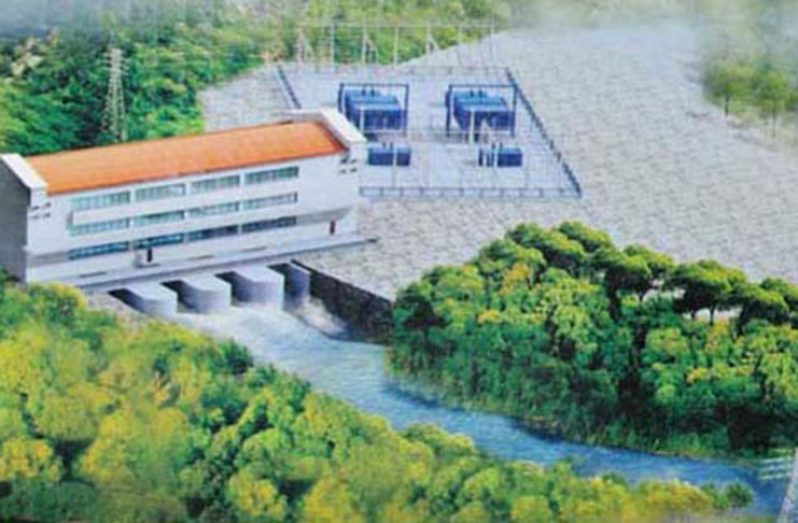–gov’t seeking proposals for initiative, in pursuit of 2025 completion
THE People’s Progressive Party/Civic (PPP/C) government is moving ahead to restart the Amaila Falls hydro-power project. On Friday evening, the Office of the Prime Minister issued a Request for Proposals (RFP) to design, build and finance the project.
In a notice published Online, the government expressed its desire to begin construction of the hydro-power plant by the second half of 2022, in pursuit of a 2025 completion and commissioning deadline.
According to the RFP, the government is seeking submissions on two fronts, the first of which is to Build-Own-Operate-Transfer (BOOT), which will cover the period starting from Commercial Operations Date. This, the notice explains, will “include all of the costs of the project to commissioning date being borne by the developer, and the project reverting to the government at the end of the BOOT period, at no cost.” Further, it specifies that “All appropriate assumptions including cost of capital, equity, debt, and operating costs should be stated” in the submissions.
Secondly, the submitted proposals will have to contain details relating to the Design-Build-Finance (D-B-F) of the project. This will require an outline of the cost/kilowatt per hour [and equivalent annual payment] for power delivered to Sophia, Georgetown, if the developer executes the Design-Build-Finance (D-B-F) model. “Design-Build-Finance contract, with all of the financing being funded by the developer, on the condition that GoG [Government of Guyana] will take over the project and financing only repayment obligations, on satisfactory completion of construction and commissioning,” the proposal notice explains, adding:
“Financing repayment will only start on successful takeover of the project in accordance with contract terms. The developer should state the project cost, financing details, and all other assumptions including operating costs and debt service.”
The advertisement also pointed to the fact that “Terms such as interest rate, loan tenure, loan conditions, capitalisation of interest during construction, and a draft financing term sheet” would have to be provided.
The government explained that currently, the Guyana Power and Light (GPL)’s Development and Expansion (D&E) plan for 2021 to 2025 projects the total capacity required in 2025 as 465 megawatt and energy of 2,900 gigawatt hours.
BLOCKED
In response to the country’s energy needs, the PPP/C government had conceptualised the Amaila Falls hydropower project, which was set to produce 165 Megawatts of power. The initiative was launched in 2009, but in 2013, it was voted down by the APNU and AFC in the National Assembly, forcing its major investor, Sithe Global Incorporated to withdraw from the initiative.
In 2014, Norway, under its climate partnership with Guyana, transferred some US$80M to the Inter-American Development Bank (IDB) to fund the project.
When the PPP/C returned to office in August 2020, it recommitted to the project, and went on to propose an energy mix aimed at utilising both natural gas, Heavy Fuel Oil, and renewables such as hydro, wind and solar.
As a matter of fact, during the parliamentary debates on the 2020 National Budget, Minister of Home Affairs, Robeson Benn had chided the A Partnership for National Unity + Alliance for Change (APNU+AFC) for dismissing the project while in government (2015-2020).
Benn, who was the Public Works Minister when the project was birthed, pointed to the report prepared by a Norwegian company called Norconsult, which was selected by the then APNU+AFC administration, in 2016, to conduct a financial model review of the high-profile Amaila Falls Project.
EMISSION FREE
In 2017, the Stabroek News released some of the findings of the review, which indicated that the only realistic path towards an “emission-free” electricity sector is via the development of Guyana’s hydro-power potential. It was noted, too, that the fastest way forward is to maintain the Amaila Falls hydro-power project as the first major step for substituting its current oil-fired generation.
The Guyana Chronicle had reported that the Amaila Falls hydropower project is expected to cost just under US$1 billion, and will be able to generate 165 megawatts of stable and reliable electricity for 11 solid months of the year, with the additional month during the dry season being used for scheduled maintenance.
Recent checks done by this newspaper determined that the project is still bankable, meaning that the financiers are still open to the idea of funding the project, and that all the technical studies are still relevant. As a result, the restart timeline is expected to be much shorter than it was before 2015.
Currently, GPL sells electricity to the nation at about US$0.33 per kWh, and this is expected to be reduced by 25 per cent within the first year of the operations of the Amaila Falls project, and by 50 per cent within five years; and by the end of 20 years by as much as 80 per cent.
In the proposal document, the government said that it expects the country’s power demands to be met by 2026.
In moving forward with the project, the government has required that proposals clearly outline the developer’s capability and credibility to execute a project of this magnitude, as well as the present capital structure for financing.
Developers are also required to submit details of proposed local content, including sub-contractors, percentage of project costs that will be locally sourced, and supporting details of same. The developers are also being asked to outline a projected timetable with key milestones for Financial Close, Commercial Operations and Commissioning of the project.
Added to that, the notice says that there shall be provision for an international third-party operator, who will operate the facility on behalf of the project company or the government.
More significantly, the project will be executed via a new Special Purpose Company (SPC), and will be issued with all previous permits, licences, and permissions, as previously existed in April 2015, “provided the developer shall have responsibility for any updates as required by law.”



.jpg)









